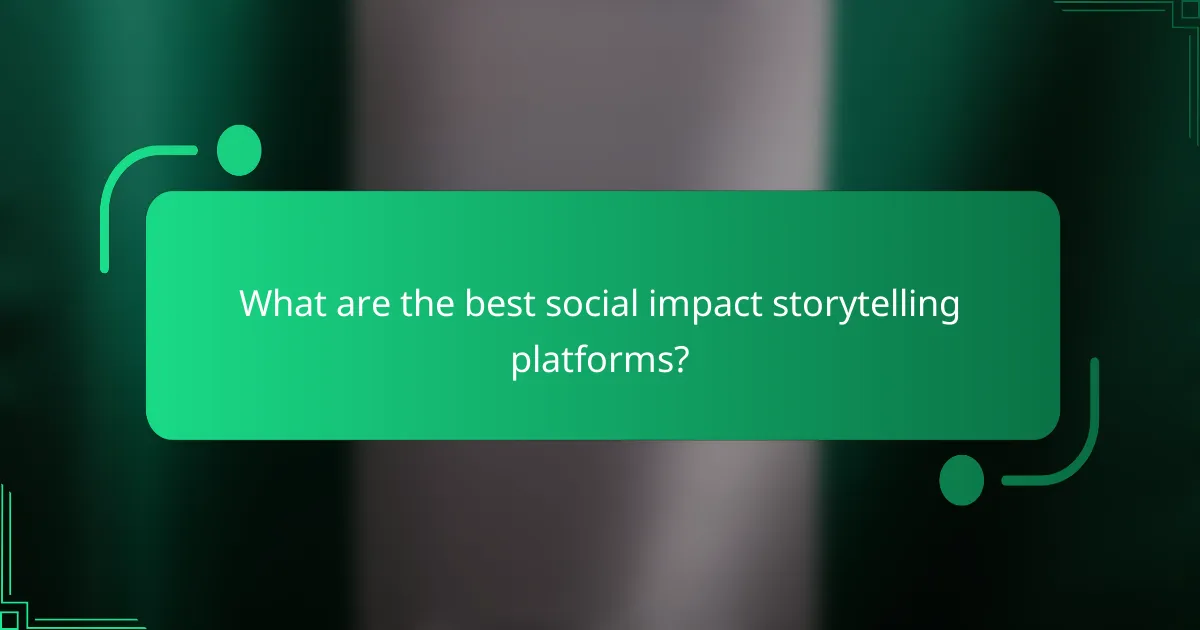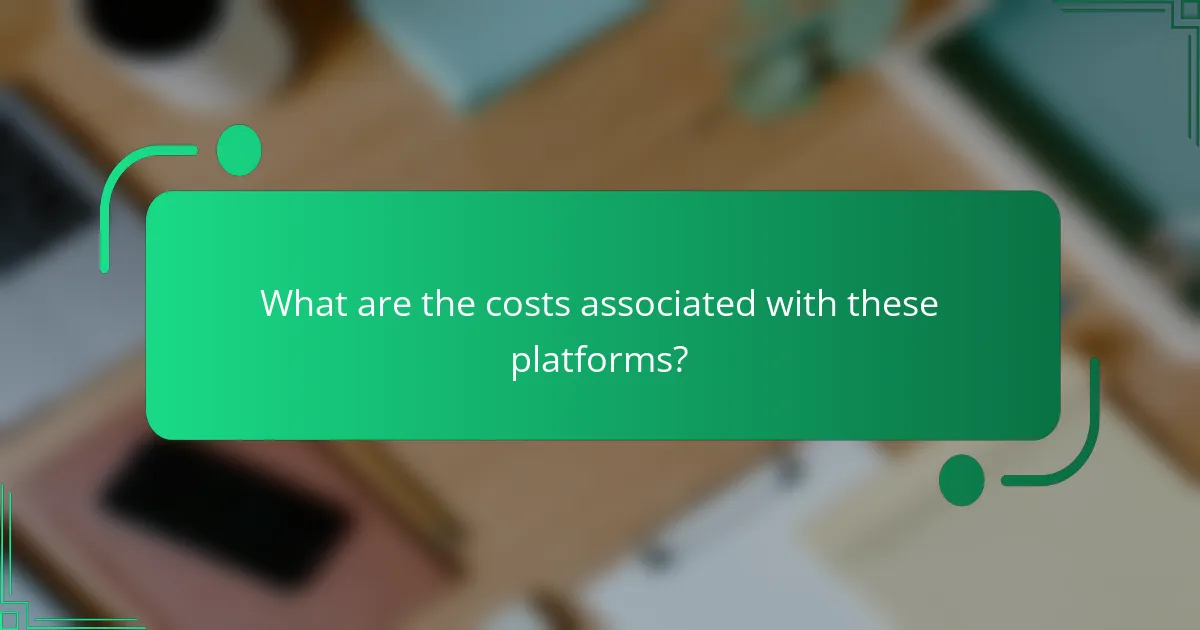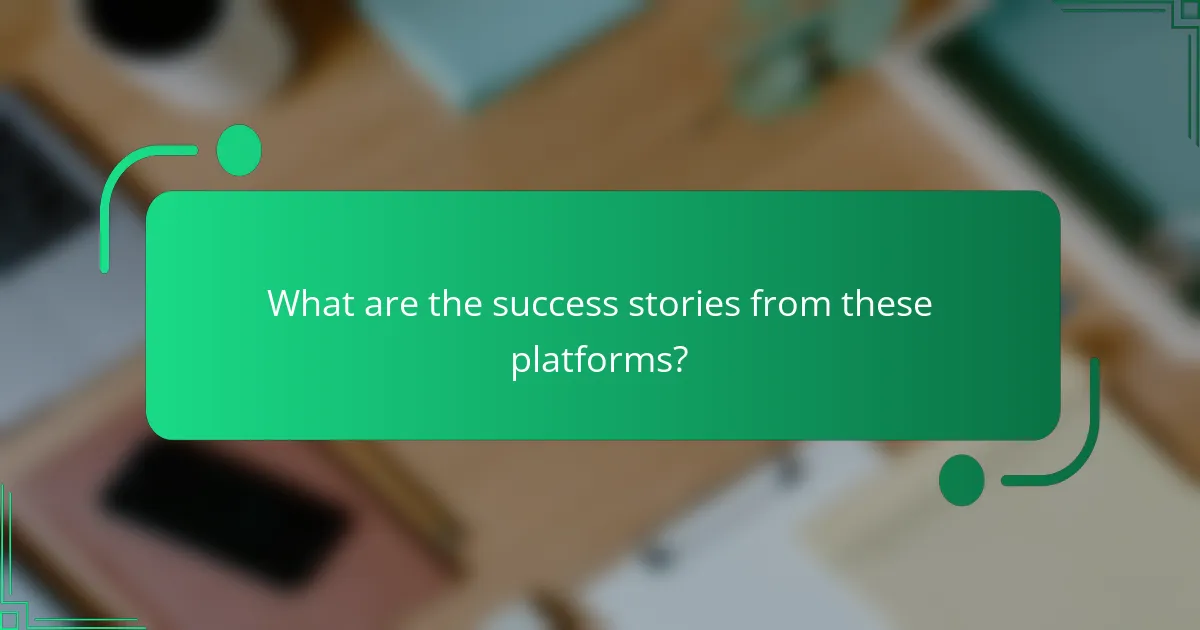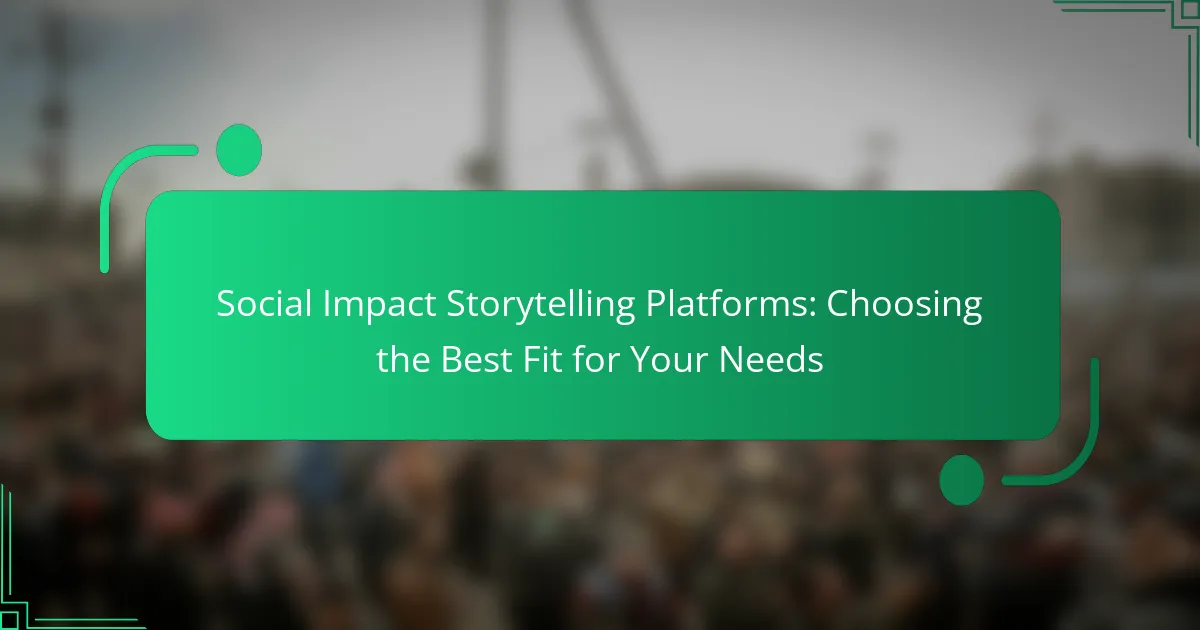In today’s digital landscape, selecting the right social impact storytelling platform is essential for effectively sharing your narrative and driving meaningful change. With options like StoryCorps, Medium, and Kickstarter, each platform offers distinct features that cater to various storytelling needs. By evaluating your audience and aligning your goals with the capabilities of these platforms, you can enhance engagement and maximize the impact of your stories.

What are the best social impact storytelling platforms?
The best social impact storytelling platforms enable individuals and organizations to share compelling narratives that drive awareness and action. Key platforms include StoryCorps, Medium, Facebook for Social Good, Kickstarter, and Patreon, each offering unique features tailored to different storytelling needs.
StoryCorps
StoryCorps is a platform dedicated to recording and sharing personal stories that highlight diverse human experiences. Users can record interviews with friends or family, which are then archived in the Library of Congress, creating a lasting impact.
Consider using StoryCorps if your goal is to capture authentic narratives that resonate emotionally. The platform is user-friendly and encourages storytelling in a conversational format, making it accessible for all ages.
Medium
Medium is a popular online publishing platform that allows users to share articles and stories on various topics, including social impact. It provides a space for writers to reach a broad audience and engage with readers through comments and claps.
When using Medium, focus on crafting high-quality, engaging content that sparks discussion. The platform’s built-in audience can amplify your message, but be mindful of the need for consistent posting to maintain visibility.
Facebook for Social Good
Facebook for Social Good offers tools and resources for nonprofits and social enterprises to promote their missions and connect with supporters. Features include fundraising tools, event promotion, and community engagement options.
Utilize this platform if you already have a presence on Facebook and want to leverage its vast user base for social impact. Be proactive in engaging with your audience through regular updates and interactive content to foster community support.
Kickstarter
Kickstarter is a crowdfunding platform that helps creators launch projects, including those with a social impact focus. It allows individuals and organizations to raise funds by offering rewards to backers in exchange for their support.
To succeed on Kickstarter, clearly articulate your project’s mission and impact. Set realistic funding goals and create compelling visuals and videos to attract potential backers. Remember that successful campaigns often engage their audience before launching to build momentum.
Patreon
Patreon is a membership platform that enables creators to earn a recurring income by providing exclusive content to their supporters. This can be particularly useful for social impact storytellers who want to maintain a steady connection with their audience.
Consider using Patreon if you have a dedicated following and can offer unique content, such as behind-the-scenes insights or early access to stories. Regularly communicate with your patrons to keep them engaged and invested in your mission.

How to choose the right platform for your needs?
Choosing the right social impact storytelling platform involves assessing your audience, evaluating features, and considering funding options. Each platform offers unique capabilities that can enhance your storytelling, so it’s crucial to align these with your specific goals and resources.
Assess audience engagement
Understanding how your audience engages with content is vital when selecting a platform. Look for platforms that provide analytics on user interaction, such as views, shares, and comments, to gauge interest and involvement. A platform that fosters community interaction can enhance engagement and create a more immersive storytelling experience.
Consider platforms that allow for real-time feedback and interaction, such as live chats or comment sections. This can help you build a loyal audience and encourage participation in your social impact initiatives.
Evaluate storytelling features
Different platforms offer various storytelling features that can enhance your narrative. Look for tools that support multimedia content, such as videos, images, and interactive elements, which can make your stories more compelling. Features like customizable templates and user-friendly editing tools can also streamline the storytelling process.
Additionally, consider the platform’s ability to integrate with other tools you may use, such as social media or email marketing services. This can help you reach a wider audience and amplify your message effectively.
Consider funding options
Funding options are a crucial factor when choosing a storytelling platform. Some platforms may charge subscription fees, while others operate on a commission basis or offer free services with premium features. Assess your budget and determine which model aligns best with your financial resources.
Explore platforms that offer grant opportunities or partnerships with organizations focused on social impact. This can provide additional funding avenues and support for your storytelling initiatives, making it easier to achieve your goals.

What are the key features of effective storytelling platforms?
Effective storytelling platforms should prioritize user engagement, provide robust analytics, and foster community interaction. These features ensure that your narratives resonate with audiences while allowing for measurable impact and connection.
User-friendly interface
A user-friendly interface is crucial for storytelling platforms as it enhances accessibility for creators and audiences alike. Look for platforms that offer intuitive navigation, drag-and-drop functionalities, and customizable templates to streamline the storytelling process.
Consider platforms that provide mobile-friendly designs, allowing users to engage with stories on various devices. This flexibility can significantly increase audience reach and participation.
Analytics and reporting tools
Analytics and reporting tools help you measure the effectiveness of your storytelling efforts. Effective platforms should provide insights into user engagement metrics, such as views, shares, and time spent on content.
Choose platforms that offer real-time data and easy-to-understand reports. This information can guide your content strategy and help you refine your storytelling approach based on audience preferences.
Community-building capabilities
Community-building capabilities are essential for fostering interaction among users. Look for platforms that allow for comments, discussions, and social sharing to create a sense of belonging and engagement around your stories.
Consider features like user profiles, forums, or collaborative storytelling options that encourage participation. A strong community can amplify your message and enhance the overall impact of your storytelling initiatives.

What are the costs associated with these platforms?
The costs associated with social impact storytelling platforms can vary significantly based on features, usage, and the specific needs of your project. Understanding these costs is crucial for budgeting and maximizing the value of your chosen platform.
Subscription fees
Subscription fees are typically the primary cost for accessing social impact storytelling platforms. These fees can range from low monthly rates to higher annual subscriptions, depending on the level of service and features offered. For example, basic plans may start around $10 to $30 per month, while premium options can exceed $100 monthly.
When evaluating subscription fees, consider what features are included, such as analytics, storage, and support. Some platforms offer tiered pricing, allowing you to choose a plan that aligns with your budget and needs.
Transaction costs
Transaction costs may apply if your platform facilitates donations or sales related to your storytelling efforts. These costs can include a percentage of each transaction or fixed fees per transaction. Generally, transaction fees range from 2% to 5% of the total amount processed.
It’s essential to factor in these costs when planning your budget, as they can add up quickly, especially for high-volume campaigns. Look for platforms that offer transparent pricing and consider any additional fees for currency conversion or international transactions.
Advertising options
Many social impact storytelling platforms provide advertising options to help amplify your message. These can include paid promotions, sponsored content, or enhanced visibility features. Costs for advertising can vary widely, often starting from a few dollars per day to hundreds, depending on the reach and targeting options.
When considering advertising, assess your goals and budget. Some platforms may offer free promotional tools or discounted rates for non-profits, making it worthwhile to explore all available options. Always track the performance of your ads to ensure a good return on investment.

What are the success stories from these platforms?
Success stories from social impact storytelling platforms showcase how individuals and organizations effectively use these tools to drive change and raise awareness. These platforms have enabled diverse voices to share their narratives, garner support, and mobilize communities around important causes.
Case study: StoryCorps
StoryCorps is a platform that allows people to record, share, and preserve personal stories. It has successfully captured thousands of narratives, emphasizing the importance of human connection and understanding. The stories shared often highlight social issues, fostering empathy and dialogue among listeners.
One notable initiative is the “StoryCorps Griot” project, which focuses on documenting the stories of African Americans. This effort has not only preserved cultural history but also provided a platform for voices that are often underrepresented in mainstream media.
Case study: Kickstarter
Kickstarter is a crowdfunding platform that has enabled countless creative projects with social impact to come to life. By allowing creators to present their ideas and seek funding directly from the public, it has democratized the funding process. Many successful campaigns have focused on social causes, from environmental sustainability to community development.
A prominent example is the “The Ocean Cleanup” project, which raised millions to develop technology aimed at removing plastic from oceans. This case illustrates how Kickstarter can effectively mobilize financial support for innovative solutions to pressing global challenges.
